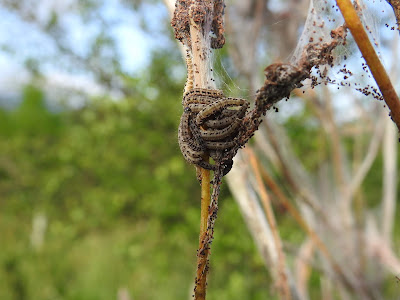Gail and I have just got back from a weeks holiday in Aberdeenshire on the edge of the eastern Cairngorms. We had a fantastic week and the weather remained dry throughout. Normally we go to western Scotland, but this year we fancied a change and the chance of some better weather perhaps. Having said that my heart still belongs to western Scotland!
Our first port of call on the Sunday following our rain soaked journey north was to Craigievar Castle. This castle is the castle that Walt Disney based his castle on. This is really a trivial fact of a castle so full of history, but our guide did make us laugh when she said on one tour an American lady said to her that the Walt Disney castle must have been the inspiration for the building of Craigievar! She obviously wasn't listening to the guide when she was told that Craigievar was built in 1570! Americans!
Craigievar Castle
In this part of Aberdeenshire there is a lot of arable land and it was quite different to see arable crops growing in what was quite hilly land. As a result of this Tree Sparrows were around in good numbers and so too were Yellowhammers. We had a number of Tree Sparrows and Yellowhammers at Craigievar and one pair of Tree Sparrows were nesting high up on the side of the castle. House Martins nested all over the castle as well, and in the woodland surrounding the castle we had a Spotted Flycatcher.
On the Monday we visited Kinnaird Head Lighthouse and Scottish Lighthouse Museum. There was a constant passage past the lighthouse at sea of Gannets, Kittiwakes, Fulmars, Guillemots, Razorbills and Sandwich Terns. Most of these species would be from Troup Head a few miles further west where Scotland's largest mainland Gannet colony is located.
Kinnaird Head Lighthouse. Robert Stevenson built a lighthouse tower
through the medieval castle!
Troup Head was spectacular and the Gannets even more spectacular. Below are a few pics to give you an idea of the atmosphere of the place, but the one thing you won't get is that characteristic smell of a seabird colony!
Close to Troup Head is the beautiful former fishing village of Pennan. Driving down the narrow road from the top of the cliffs to the village, with lots of hairpin bends, reminded me of some of the fishing villages in Cornwall.
During the week we visited Brodie Castle and having cake and coffee outside in the late afternoon sunshine the cheeky wee male Chaffinch below stole cake crumbs from our plates!
Brodie Castle
One of Gail's passions is history and when we are on holiday we try and indulge in as much history and archaeology as we can. On a dreich afternoon (the only one) we visited Whitehill Stone Circle that is set in a Forestry commission forest clearing. The walk up to the stone circle was along a track through the forest and along the forest edge there is always an element of the natural woodland that would occur in this area, and this is where any birds will be found. We encountered two Blackcaps, two Goldcrests, three Coal Tits, two Willow Warblers, a Siskin, a Lesser Redpoll and a pair of Bullfinches.
Willow Warbler
Whitehill Stone Circle
On our last full day in Aberdeenshire we spent the morning at Muir of Dinnet NNR. At the heart of the Reserve are Lochs Davan and
Kinord, with their near pure water and associated bogs and fens
providing ideal habitat for a wide mix of species; from rare water
beetles to the elusive Otter, feeding and breeding on the reserve.
During winter, the lochs are an important roost site, attracting
migrating geese and other wildfowl.
Dry heaths, including the internationally important Bearberry heath, thrive on the drier hummocky ground. The heaths
support rare moths, such as the Netted Mountain and cousin German, and
in summer are home to ground nesting birds, such as Curlew and Meadow Pipit. Young pine and birch now cover large areas of the reserve and
provide an interesting transition from open heath, young scrub to pine
and Birch woodland. These woodlands also support a rich variety of
invertebrates and breeding birds including, the Kentish Glory moth, Wood Warbler and Chaffinch.
Gail and I did a circular walk from the visitor centre through the woodland, around the lochs and back. Just to rewind before we arrived at the visitor centre we passed a recently cut silage field and a Red Kite was flying low over the field, presumably looking for carrion. Later on our walk we saw the Red Kite again.
Walking through the woodland we had a number of birds including two calling Cuckoos, one of which we got fleeting views of as it flew through the open woodland.
Birch and Pine Woodland
Other species we recorded included five Siskins, a Goldcrest, a Great Spotted Woodpecker, eight Willow Warblers, a singing Garden Warbler, two Coal Tits, a Song Thrush, a Lesser Redpoll, six Long-tailed Tits, a juvenile Yellowhammer, four Reed Buntings, 170 Lapwings in a field adjacent to the woodland and two Goldeneyes on the loch.
Amongst the 170 Lapwings were some large flying young, like this one
There was a number of invertebrates abroad including lots of Chimney Sweeper moths and Common Blue Damselflies.
Common Blue Damselflies
Along the woodland path we came across this Oak Eggar Moth caterpillar below that proceeded to demonstrate that it could cross anything in it's path!
I'll finish with a few miscellaneous pictures of places we visited that I haven't covered above.
Acorn Bothy; the cottage we stayed in
Celtic Cross at Muir of Dinnet NNR
Howe of Cromar














































